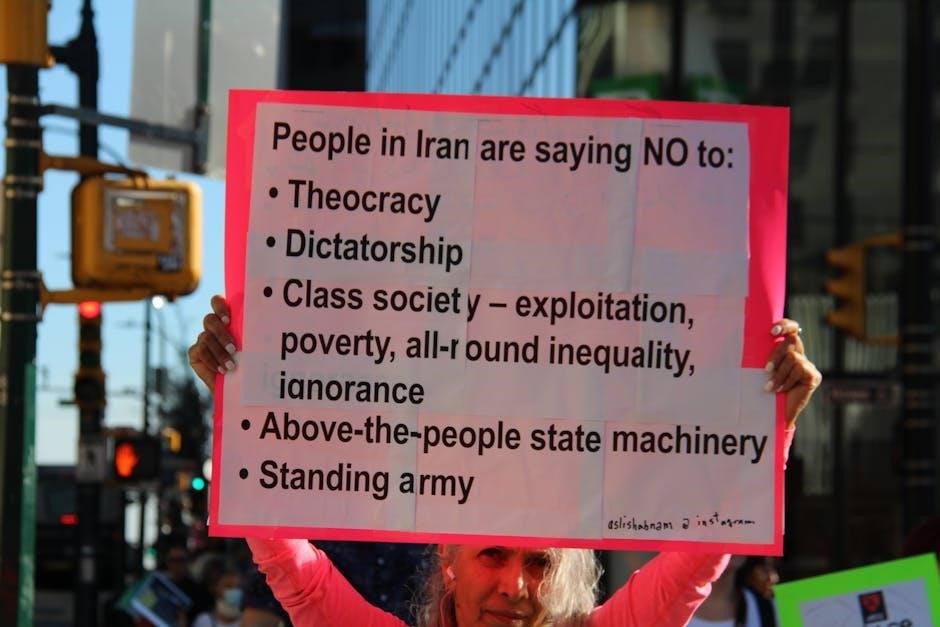
state and revolution pdf
Published in 1917, Lenin’s The State and Revolution is a foundational Marxist text exploring the role of the state, its transition, and eventual withering away.
1.1 Historical Context and Significance
Written in August-September 1917, The State and Revolution emerged amid the turmoil of World War I and the Russian Revolution. Lenin, in hiding, crafted this seminal work to address the urgent need for Marxist clarity on the state’s role. Drawing on Marx’s analyses of the Paris Commune, Lenin argued for the proletariat’s revolutionary takeover and the state’s eventual abolition. This text became a cornerstone of Bolshevik ideology, shaping the 1917 revolution and influencing Marxist theory globally. Its historical significance lies in its precise articulation of state transition and communist goals.
1.2 Overview of Lenin’s Arguments
Lenin’s central argument in The State and Revolution posits that the state is a tool of class oppression, necessary for the ruling class to maintain power. He asserts that the capitalist state must be overthrown by the proletariat to establish a dictatorship of the working class. Drawing on Marx, Lenin emphasizes the transitional nature of this state, which will “wither away” as classless society emerges. He critiques reformism and advocates for revolutionary action, rejecting the idea of using the existing state apparatus to achieve socialism. Lenin’s analysis provides a clear roadmap for revolutionary strategy and post-capitalist governance.
Key Concepts in “The State and Revolution”
Lenin explores the state as a tool of class oppression, advocating for its overthrow by the proletariat. He emphasizes the “withering away” of the state, transitioning to a free people’s state, and the abolition of capitalist tyranny through revolutionary action.
2.1 The Withering Away of the State
Lenin introduces the concept of the state’s “withering away,” arguing that as socialism progresses, the state transitions from an oppressive tool of class domination to a free people’s state. Eventually, it becomes unnecessary, as people manage society themselves. This process is central to Lenin’s vision of a communist society, where the state loses its coercive functions and evolves into a voluntary, classless organization. The idea reflects Marx’s belief that the state must disappear for true freedom to emerge, emphasizing the transition from state control to self-governance.
2.2 The Role of the Proletariat in Revolution
Lenin emphasizes the proletariat’s central role in revolution, arguing that they must lead the overthrow of the bourgeoisie to establish a dictatorship of the proletariat. This transitional phase ensures the destruction of the old state apparatus and the creation of a new system controlled by the working class. The proletariat’s historical mission is to abolish capitalist exploitation and guide society toward communism. Lenin stresses that the revolution’s success depends on the proletariat’s ability to organize and seize power, smashing the bourgeois state to build a new, classless society. This concept is pivotal to Lenin’s vision of revolutionary change.
The Structure of the Book
The State and Revolution is divided into chapters analyzing class society, historical revolutions, and the Paris Commune, providing a structured exploration of Marxist state theory.

3.1 Chapter I: Class Society and the State
Chapter I examines the origins of the state, linking it to class society and economic systems. Lenin argues that the state arises from class contradictions, functioning as an instrument of oppression. He traces its evolution from ancient slave-owning societies to feudal and bourgeois systems. The state, Lenin contends, cannot be reformed to serve the working class under capitalism. Historical examples illustrate how the state maintains class dominance, emphasizing its role in perpetuating exploitation and the necessity of its overthrow in a proletarian revolution.
3.2 Chapter II: The Experience of 1848-51
Chapter II delves into the revolutions of 1848-51, emphasizing the bourgeoisie’s rise to power and the subsequent strengthening of the state as a tool of oppression. Lenin highlights how the Paris June Days of 1848 marked a turning point, revealing the state’s role in suppressing the proletariat. This period, according to Lenin, demonstrated the class nature of the state and its transformation into an instrument of bourgeois domination. The chapter underscores the limitations of petit-bourgeois revolutions and the necessity of a proletarian-led revolution to abolish the state entirely, aligning with Lenin’s broader argument in The State and Revolution.
3.3 Chapter III: The Experience of the Paris Commune of 1871
Chapter II examines the revolutionary wave of 1848-51, focusing on the rise of bourgeois dominance and the state’s role in suppressing the proletariat. Lenin highlights how the June Days of 1848 in Paris marked a decisive shift, revealing the state as a tool of class oppression. This period demonstrated the limitations of petit-bourgeois revolutions and the necessity for a proletarian-led revolution to abolish the state entirely, aligning with Lenin’s broader argument in The State and Revolution.

The Proletarian Revolution and the Dictatorship of the Proletariat
Lenin emphasizes the necessity of the dictatorship of the proletariat as a transitional phase to eliminate the bourgeois state, leading to a classless society.
4.1 The Transition from Bourgeois to Proletarian State
Lenin argues that the bourgeois state must be dismantled to establish a proletarian state. This transition involves the dictatorship of the proletariat, a necessary phase to abolish capitalist exploitation and class domination. The bourgeois state, as an instrument of oppression, cannot be reformed but must be destroyed. The proletarian state, representing the interests of the working class, will act as a temporary measure to consolidate power and guide society toward a classless, stateless communist system. This transition is vital for achieving true liberation and equality for the masses.
4.2 The Role of the Commune in the Revolution
The Paris Commune of 1871, as analyzed by Lenin, exemplifies the role of the commune in revolution. It demonstrated that the working class could seize power and establish a new state form. The commune abolished the old state machinery, introducing elected officials who were recallable and accountable. Lenin viewed the commune as a prototype for the dictatorship of the proletariat, emphasizing its democratic and transitional nature. Though short-lived, the commune provided practical lessons for revolutionaries, showcasing the potential for a state that serves the people rather than oppress them, paving the way for a classless society.

Lenin’s Vision of a Free State
Lenin envisioned a free state as a transformed society where the state serves the people, not the bourgeoisie, ultimately leading to its abolition.
5.1 The Transformation of the State into a Free People’s State
Lenin argued that the state must transform from a tool of oppression into a free people’s state, where power is held by the proletariat. This transformation involves dismantling capitalist structures and establishing a dictatorship of the proletariat. The state, initially a weapon of class domination, becomes a democratic instrument for the masses. Lenin emphasized that this transition is temporary, as the state will eventually wither away, giving rise to a classless, stateless society. This vision underscores Lenin’s belief in the state’s role as a revolutionary tool.
5.2 The Abolition of Capitalist Tyranny
Lenin argued for the complete dismantling of capitalist structures, viewing the state as a tool of bourgeois oppression. He emphasized that the proletariat must seize power to abolish capitalist tyranny, replacing it with a dictatorship of the proletariat. This transitional phase would suppress the bourgeoisie and establish a socialist system. Lenin believed that once capitalism was eradicated, the state would wither away, leading to a classless society. The abolition of capitalist tyranny was central to Lenin’s vision, aiming to liberate the working class from exploitation and oppression.

The Legacy of “The State and Revolution”
Lenin’s work remains a cornerstone of Marxist theory, influencing revolutions globally and shaping socialist movements. Its ideas on state transformation continue to inspire political discourse today.
6.1 Impact on Marxist Theory and Practice
Lenin’s The State and Revolution significantly influenced Marxist theory by clarifying the state’s role in class struggle and its eventual abolition. It provided a clear framework for understanding the transition from capitalist to socialist systems, emphasizing the dictatorship of the proletariat as a necessary phase. The text also inspired practical applications, shaping socialist movements worldwide and informing revolutionary strategies. Its analysis of the Paris Commune and the withering away of the state remains central to Marxist discourse, offering a vision of a classless society. The work’s theoretical depth continues to guide socialist theory and practice globally.
6.2 Relevance in Modern Political Discourse
Lenin’s The State and Revolution remains highly relevant in contemporary political discourse, offering insights into the nature of power and governance. Its critique of capitalist state structures resonates amid modern debates on inequality and systemic oppression. The text’s emphasis on the state as a tool of class domination continues to inspire movements advocating for radical social change. Additionally, its vision of a stateless society aligns with anarchist and socialist critiques of centralized power, making it a key reference in discussions about democracy, justice, and the future of political systems.